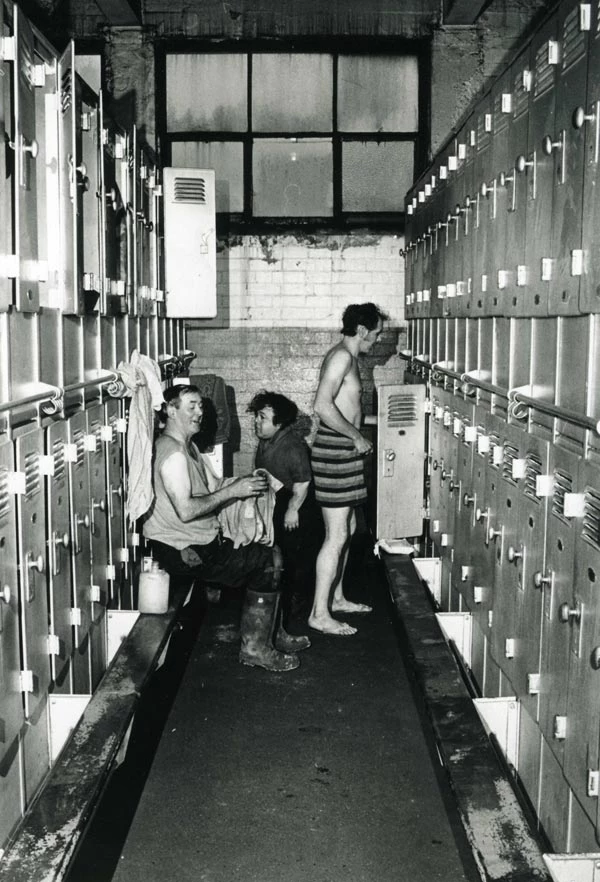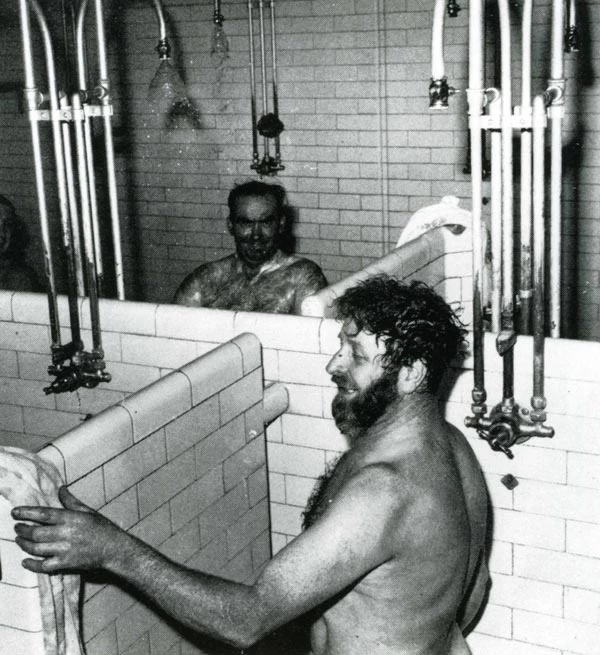Pithead Baths
The pithead baths at Bit Pit: National Coal Museum
All prevailing coal-dust
Before pithead baths became widely available, most coal miners, already exhausted from a day's work had little choice but to travel home from work still filthy with coal dust. Their clothing was often soaking with sweat and mine water and they were at risk from contracting pneumonia, bronchitis or rheumatism. Once home they had the task of removing as much of the dirt as possible in a tin bath in front of the fire.
The women of the house were usually responsible for the heating of water for the miner's bath and the cleaning and drying of his clothes. In addition it was a constant battle to clean the house from the all-prevailing coal dust. This was never ending and back breaking work and exhaustion and physical strain often led to serious health problems, leading in some cases to premature births and miscarriages.
It took considerable lobbying by social reformers, working under the banner of the 'Pithead Baths Movement', to convince the Government, mine owners and even some of the miners and their wives, that pithead baths were needed. From the initial campaigns of the 1890s it was a long, hard struggle to the establishment in 1926 of a special fund for the building of baths under the auspices of the Miners' Welfare Committee.
Social Reform
Pithead baths had been in use in Belgium, France and Germany since the 1880s. In 1913, a delegation was sent by David Davies, the proprietor of the Ocean Coal Company and an advocate of social reform, to see these European baths. This visit led to the building of the first Welsh baths at Deep Navigation Colliery, Treharris, in 1916. The success of the Deep Navigation baths played a key part in the propaganda campaign by those who wished to see pithead baths at every Welsh colliery.
In 1919 the British Government established a Royal Commission, (the 'Sankey Commission'), to investigate social and living conditions in the coalfields. As a result a 'Miners' Welfare Fund' was set up to '... improve the social well being, recreation, and condition of living of workers in or about coal mines.' This fund gained its income through a levy of a penny on every ton of coal mined. The fund was used for various purposes including the provision of playing fields, swimming pools, libraries, and institutes. From 1926, an additional levy was raised specifically to fund a baths building programme.
Modern Architectural style
During the period the Miners' Welfare Fund was in existence, from 1921 to 1952, over 400 pithead baths were built in Britain. The Miners' Welfare Committee's own architects' department established the most cost-effective way of constructing, equipping and operating baths buildings. By the 1930s, a 'house style' had developed, based on the 'International Modern Movement' of architectural design.
Baths stood out amongst other colliery buildings with their flat roofs, clean lines and the plentiful use of glass to give a natural light and airy feel. Some baths, such as the one at Big Pit, were rendered white which, even today, makes it a prominent landmark on the hillside. The limited resources available to the Miners' Welfare Committee meant that many Welsh collieries were not provided with baths until the 1950s. After the nationalisation of the coal industry in 1947 the provision of pithead baths became the responsibility of the National Coal Board.


Comments - (3)
try to build the solid foundation of the bricks that others have taken, life will not be so hard.
My father (Roy Phillips) was the contracts manager for the Gelli pithead baths consruction in the mid 1950's, would you have the year/years of the start date and it's completion, sadly my dad passed away in 1957.
Kind regards Paul
It would be great if you could help me. I have been trying to establish when pithead baths were put into Bargoed, Pengam and Britannia collieries.I am researching for a book I am writing and it is to check if my memory is correct. I have been told that I used to meet my father from work and even when he was dirty I could identify him. It must have been in the early 1950s. 53 0r 54.
many thanks
Elaine